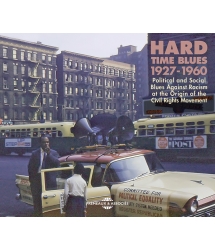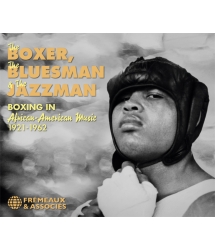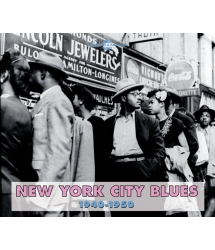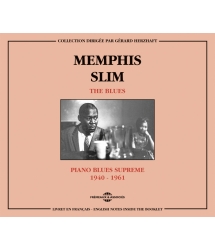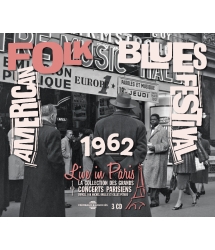- Our Catalog
- Philosophy
- Philosophers of the 20th century and today
- History of Philosophy (PUF)
- Counter-History and Brief Encyclopedia by Michel Onfray
- The philosophical work explained by Luc Ferry
- Ancient thought
- Thinkers of yesterday as seen by the philosophers of today
- Historical philosophical texts interpreted by great actors
- History
- Books (in French)
- Social science
- Historical words
- Audiobooks & Literature
- Our Catalog
- Jazz
- Blues
- Rock - Country - Cajun
- French song
- World music
- Africa
- France
- Québec / Canada
- Hawaï
- West Indies
- Caribbean
- Cuba & Afro-cubain
- Mexico
- South America
- Tango
- Brazil
- Tzigane / Gypsy
- Fado / Portugal
- Flamenco / Spain
- Yiddish / Israel
- China
- Tibet / Nepal
- Asia
- Indian Ocean / Madagascar
- Japan
- Indonesia
- Oceania
- India
- Bangladesh
- USSR / Communist songs
- World music / Miscellaneous
- Classical music
- Composers - Movie Soundtracks
- Sounds of nature
- Our Catalog
- Youth
- Philosophy
- News
- How to order ?
- Receive the catalog
- Manifesto
- Dictionnary











- Our Catalog
- Philosophy
- Philosophers of the 20th century and today
- History of Philosophy (PUF)
- Counter-History and Brief Encyclopedia by Michel Onfray
- The philosophical work explained by Luc Ferry
- Ancient thought
- Thinkers of yesterday as seen by the philosophers of today
- Historical philosophical texts interpreted by great actors
- History
- Books (in French)
- Social science
- Historical words
- Audiobooks & Literature
- Our Catalog
- Jazz
- Blues
- Rock - Country - Cajun
- French song
- World music
- Africa
- France
- Québec / Canada
- Hawaï
- West Indies
- Caribbean
- Cuba & Afro-cubain
- Mexico
- South America
- Tango
- Brazil
- Tzigane / Gypsy
- Fado / Portugal
- Flamenco / Spain
- Yiddish / Israel
- China
- Tibet / Nepal
- Asia
- Indian Ocean / Madagascar
- Japan
- Indonesia
- Oceania
- India
- Bangladesh
- USSR / Communist songs
- World music / Miscellaneous
- Classical music
- Composers - Movie Soundtracks
- Sounds of nature
- Our Catalog
- Youth
- Philosophy
- News
- How to order ?
- Receive the catalog
- Manifesto
- Dictionnary
27 MAI 1961
SLIM MEMPHIS
Ref.: FA5725
EAN : 3561302572529
Label : Frémeaux & Associés
Total duration of the pack : 1 hours 17 minutes
Nbre. CD : 1
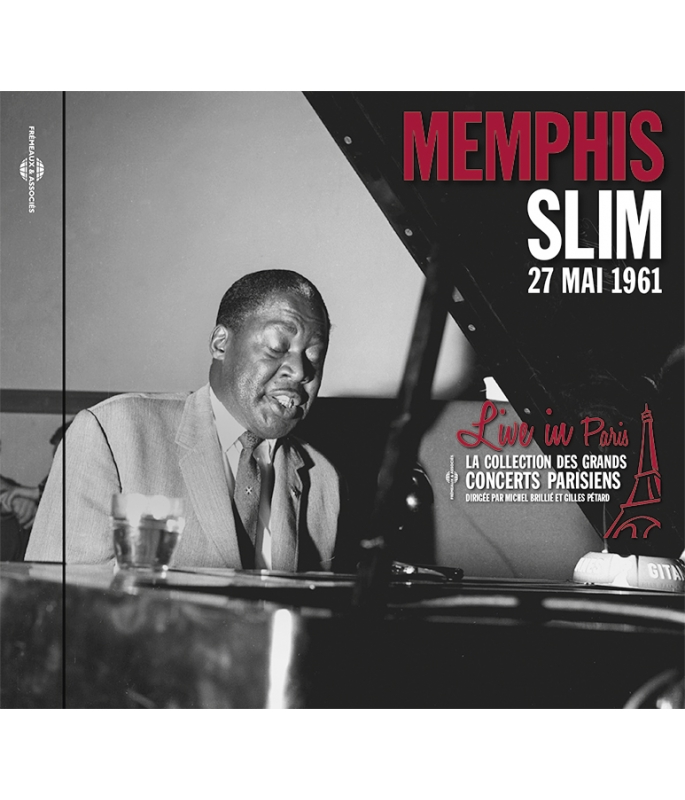
27 MAI 1961
27 MAI 1961
A major blues stylist, Memphis Slim was one of the most emblematic and eminent bluesmen to come out of Chicago. He widely contributed to break blues in Europe and moved to Paris in 1962. Anyone who was lucky enough to catch one of his shows will never forget those smoky nights where the audience was literally entranced by the power of his piano playing, serving his shouter, albeit distinguished voice. Patrick FRÉMEAUX
The Live in Paris collection by Michel Brillié allows listeners to hear previously-unreleased recordings (made at concerts and private- or radio-sessions) by the great 20th stars in jazz, rock & roll and song. These “live” takes, and the artists’ rapport with their audiences, gives these performances an additional soul and sensibility in counterpoint to the rigorous demands of studio recordings. Particular care was taken when restoring the sound of these tapes in order to meet CD standards while preserving the original colours of the period. Patrick FRÉMEAUX & Gilles PÉTARD
-
PisteTitleMain artistAutorDurationRegistered in
-
1Chicago Boogie WoogieMemphis SlimPeter Chatman00:05:031961
-
2How Long How Long BluesMemphis SlimL. Carr00:03:211961
-
3Beer Drinkin' WomanMemphis SlimPeter Chatman00:04:471961
-
4Pee Wee's BluesMemphis SlimPeter Chatman00:04:001961
-
5Keep Your Hand On Your HeartMemphis SlimBig Bill Bronzy00:04:571961
-
6All By MyselfMemphis SlimBig Bill Bronzy00:01:501961
-
7Miss Ida BMemphis SlimBig Bill Bronzy00:04:551961
-
8Shake Rattle And RollMemphis SlimCharles E. Calhoun00:03:271961
-
9A Letter HomeMemphis SlimPeter Chatman00:04:401961
-
10Laisse les bons temps roulerMemphis SlimPeter Chatman00:02:221961
-
11Chicago StompMemphis SlimPeter Chatman00:01:221961
-
12Pigalle LoveMemphis SlimPeter Chatman00:03:451961
-
13Introduction To Kansas CityMemphis SlimPeter Chatman00:01:171961
-
14Kansas City BluesMemphis SlimJackson00:02:361961
-
15Kansas City Blues 2Memphis SlimPete Johnson00:03:371961
-
16KC LovingMemphis SlimJerry Lieber00:03:121961
-
17Frankie And JohnnyMemphis SlimTraditionnel00:02:421961
-
18Unidentified BoogieMemphis SlimPeter Chatman00:05:011961
-
19Three Women BluesMemphis SlimPeter Chatman00:04:211961
-
20I Feel So GoodMemphis SlimBig Bill Bronzy00:02:461961
-
21I Just Want To Make Love To YouMemphis SlimWillie Dixon00:03:371961
-
22If You See KayMemphis SlimPeter Chatman00:02:141961
-
23Roll Em PeteMemphis SlimPete Johnson00:01:391961
FA5725 Memphis Slim
Memphis Slim
27 MAI 1961
Live in Paris
La collection des grands
concerts parisiens
Dirigée par Michel Brillié et Gilles Pétard
Memphis Slim Live in Paris 27 mai 1961
Par Michel Brillié
Memphis Slim, la grande classe du blues
« Tu sais, à Paris, il y a un endroit où on monte sur une bicyclette, où les filles montent sur des bicyclettes, et la première qu’on attrape, on lui fait l’amour tout de suite. » Memphis Slim regarde son pote Big Bill Broonzy d’un œil incrédule. C’est le début des fifties, et Broonzy revient d’Europe où il a chanté pour la première fois. Il a sans doute imaginé ces « 6 jours du Vel d’Hiv de l’amour », peut-être pour convaincre Slim de l’accompagner la prochaine fois… L’idée reste quelque part dans un coin de la tête du pianiste-chanteur et fait son chemin. Après tout, qu’a-t-il à perdre ? La vie d’un bluesman aux USA n’est pas forcément enviable… Big Bill l’a bien décrit :
« If you was white, should be all right,
If you was brown, stick around,
But as you’s black, git back git back git back… »1
Slim a roulé et reroulé sa bosse aux States. De Memphis à Chicago, où il s’improvise bootlegger et vend du whisky de contrebande à ses voisins Tampa Red ou Big Bill, dont il devient le pianiste. Mais la concurrence est rude, et l’idée d’émigrer vers un terrain vierge – l’Europe ? – reste présente.
You gotta move
En attendant, c’est la galère habituelle. A la fin des 50s, avec son ami Willie (Dixon) ils sont un peu à la ramasse. Ils tournent dans les cafés du Nord-Est des USA, repartent à Chicago. Début 1961, En manque de gigs, Memphis et Willie dégottent un engagement dans un club de Haïfa, en Israël. Au printemps, fauchés, les deux compères atterrissent à Paris pour, paraît-il changer leurs livres israéliennes en francs suisses. Ils se renflouent un peu en jouant aux Trois Mailletz – déjà. Selon Slim lui-même2, c’est le Hot Club de France qui a organisé la tournée, et l’homme se retrouve ainsi ce fameux soir du 27 mai 1961 à l’Olympia. Frank Ténot et Daniel Filipacchi y accueillent le bluesman dans leur programmation de Paris Jazz Concerts, leur société de production de spectacles live. Trente ans plus tard, en 1992, Ténot évoque le souvenir de ces bluesmen qui tentaient leur chance en France : « Abandonné à Paris pendant les années 50, Big Bill Broonzy m’avait envoyé une lettre dramatique pour me signaler qu’il ne pouvait plus payer sa chambre dans un hôtel minable de la rue Cler. En 1961, avec Memphis Slim à l’Olympia, un concert patronné par Europe N°1 n’avait attiré que 250 personnes. Aujourd’hui, John Lee Hooker est en tête des charts, et il avoue lui-même : « Je suis heureux de recevoir enfin des royalties, mais je chantais peut-être mieux il y a 30 ans.3»
Frank a sans doute vu les chiffres…de la Préfecture de Police, car Jazz Hot, en faisant le compte rendu de la soirée, est plus généreux : « C’est devant une assistance plus qu’honorable de 500 personnes que le concert s’est déroulé », écrit le journaliste. « Je garderai le souvenir de la voix puissante de Memphis Slim, de sa vigoureuse et intensément « bluesy » partie de piano et de sa décontraction sur scène. Tout à fait à son aise, Slim a présenté ses morceaux dans une ambiance qui ne manquait pas d’humour, n’hésitant pas, à l’instar de ce que faisait Big Bill Broonzy, à raconter de petites anecdotes que le public avait l’air de piger (à en juger par les rires qui fusaient). »4
Pigalle Love
La capitale plait à «l’homme à la zébrure blanche »5. Ou alors c’est autre chose. Francis Hofstein – psychanalyste, écrivain et journaliste – l’a bien connu dès 1962. « Ils venaient pour la liberté, se balader, courir les filles, trouver du travail, mais ce n’était pas dominant. » Memphis explique son exil d’une façon très pragmatique : « Je suis venu en France parce que je n’avais pas de rival » avoue-t-il à moitié en plaisantant6. « Chez moi aux States je glandais ou je trafiquais, alors qu’ici, j’ai plein de travail, je me régale de la gastronomie, et je m’éclate. Et en Europe, une vedette reste toujours une vedette. »
Quelque part entre 1961 et 1962, Slim se fixe définitivement à Paris. Sans doute près des Trois Mailletz, le club qui va devenir son port d’attache, ainsi que nombre d’autres musiciens, Champion Jack Dupree, Bill Coleman… Big Bill Broonzy y a fait le bœuf, aussi. L’endroit est tenu d’une main de fer par Mme Calvet, une petite dame blonde qui a plusieurs cordes à son arc. « Elle avait aménagé, en annexe, une sorte de petit musée, une chambre des tortures… Mme Calvet collectionnait les instruments de torture du Moyen-âge ! »7
En Octobre 62, Memphis Slim organise avec Dixon le tout premier American Folk Blues Festival, la tournée cultissime de Horst Lippman et Fritz Rau qui fera venir à l’Olympia, ou au Free Trade Hall de Manchester, la fine fleur des aficionados du blues : Jimmy Page, Brian Jones, Keith Richards et Mick Jagger.8 Memphis Slim devient alors une figure familière des nuits de Paris : rive gauche donc, aux Trois Mailletz ; rive droite, dans un club un peu trop éclairé de la rue du Colisée, le Living Room. Il y retrouve ses collègues Art Simmons, Aaron Bridgers, Hazel Scott. L’endroit était un jam spot favori pour les musiciens, Michel Legrand, Claude Nougaro, qui aimaient le toucher particulier du piano local, un « Grotrian Steinweg ». Les jeunes étudiants sages du quartier (dont je fais partie) se mettent à fréquenter la salle toute en longueur du Living. Lorsque Slim y jouait de temps à autre, « on se mettait juste à côté pour le regarder : c’était étonnant, ses doigts étaient tellement longs et fins, qu’on avait l’impression qu’il frappait les touches du Grotrian avec toute sa dernière phalange, et pas juste avec le bout », se souvient Marc Exiga, un habitué qui me fait découvrir le club. Et puis il y avait la carrure de Slim... Francis Hofstein : « Toujours bien habillé, costume sombre, attentif à sa façon de se présenter… Avec une certaine distance, une prestance… il en imposait. »
De l’autre côté de la Seine, la cave des Trois Mailletz va devenir le souvenir indélébile de centaines de étudiants du Quartier Latin, tel Alain Frémeaux.9
Hello Memphis I’m Glad to Be in Your Town…
La vie est belle à Paris. Memphis y gagne sa vie de mieux en mieux. Il soigne son train de vie : appartement cossu boulevard Suchet, dans le 16e arrondissement. Voitures de luxe : Jaguar, Rolls-Royce. Diners dans les grands restaurants, Maxim’s, La Tour d’Argent, Lasserre… Le chanteur pianiste tourne beaucoup, partout, en France et en Europe. Et puis il y a les droits d’auteur : c’est lui qui a écrit des classiques comme « Everyday I Have the Blues » ou « Mother Earth », alors ça tombe…
A Paris, il a sa cour : Hazel Scott, Mae Mercer, ses endroits, le Living, le Bilboquet, la Calavados où il passe écouter son pote le pianiste Joe Turner. Et enfin son meilleur ami musico : le guitariste Mickey Baker, qui s’est établit en France en 1960, après son heure de gloire américaine avec le hit « Love Is Strange ». La famille des bluesmen expats parisiens est bien soudée. Il n’y avait pas de rivalité entre eux ; chacun a son truc. Le roi Memphis se trouve une stature de ministre plénipotentiaire de l’Empire du Blues. Chez lui, il reçoit la fine fleur des musiciens de passage. En 1964, le tout jeune assistant radio Philippe Rault - qui deviendra son producteur - traîne Eric Burdon et les Animals aux Trois Mailletz pour aller écouter le maître... Quelques années plus tard, Philippe est invité à diner un soir chez Slim, et se retrouve en compagnie d’un invité de passage venu « payer son tribut » : Muddy Waters himself, avec tous ses musiciens du South Side de Chicago. De son côté, Francis Hofstein l’a accompagné à Orly pour accueillir en son bon royaume de France un autre monarque, B.B. King. Les soirées chez « King Memphis » voient défiler Johnny Griffin, Max Roach, Abbey Lincoln… Quand Buddy Guy enregistre au Château d’Hérouville avec le pianiste, il accueille Slim, son hôte parisien, avec un « Hello Memphis I’m glad to be in your town.. »10 A Paris, terre de blues, Slim règne.
Et même lorsqu’il faut aller propager la bonne parole et prendre la route, tout se fait en grand style et en Rolls, excusez du peu. Christian Casoni :
« Début des années 70, entre Nancy et Paris. Une Silver Ghost immatriculée 10 ATT 75 trace dans la nuit, nettement au-dessus des chiffres peints sur ces grandes sucettes de tôle qui tapinent au bord des routes. Le batteur Michel Denis tient le volant. Slim lui a lancé les clés de la Rolls après le concert. Il était claqué, il est monté s’allonger à l’arrière. Mais voilà les motards. Denis se range. Les flics avisent le carrosse, ils voient un Blanc au volant, un Noir couché sur la banquette… « Ça va pour cette fois mais, à l’avenir, laissez conduire votre chauffeur ! »11
Le racisme ordinaire est toujours présent. Francis Hofstein, son ami de Strasbourg, revoit comment Memphis Slim s’en sortait : « Aidé par sa taille, un mètre quatre-vingt-dix, il parvenait à garder ses distances, et il faisait attention à ce qu’il disait. En France, et en Europe, même s’il n’y avait pas de Ku Klux Klan, il évoluait dans un monde de blancs et il gardait donc ses réflexes de protection dans un milieu qui n’était pas le sien. »
Old Times, New Times
Memphis Slim est désormais marié à une jeune française, Christine, il est père d’une petite fille, Nathalie – il a aussi oublié qu’il était déjà marié aux USA à Chicago – « Ca se faisait beaucoup dans le milieu du blues de l’époque », dit en souriant Philippe Rault. En ce début des seventies, Philippe va produire avec Memphis Slim une série d’albums très créatifs, qui vont présenter l’artiste sous des lumières différentes.12
Pour les français, le bluesman est devenu un notable. En 1986, Jack Lang le nomme Commandeur des Arts et des Lettres. C’est le moment de faire le point. Dans une longue interview parue quelques mois avant sa mort, Francis Hofstein lui pose la question de but en blanc :
- C’est quoi ça Memphis Slim ?
- Un bluesman qui a grandi en Israël et qui vit en France …/… Je suis une sorte d’évangéliste, un missionnaire qui prêche et enseigne le blues.13
Dans son domicile du 13e arrondissement de Paris, 30 ans après que Slim soit parti, je repose la question à son ami Francis. « S’il me fallait définir Memphis Slim, je dirais élégance, distinction. Léger, fin, en tout cas dans son rapport au monde, au dehors il ne pesait pas. »
Un mois après sa mort le 24 février 1988, Hofstein clôture son hommage à son ami « américain, noir, musicien, qui aurait pu être mon père » :
Un homme fier et discret, chaleureux et réservé, soucieux d’indépendance autant que de reconnaissance, plein de tact, de gentillesse et d’humour, tel était Memphis Slim, pianiste et chanteur de blues.14
Michel BRILLIÉ
© FRÉMEAUX & ASSOCIÉS 2018
C’était un 15 novembre. Je m’en souviens encore. L’année : 1962. J’avais vingt-deux ans. J’étais venu avec un ami au cabaret des Trois Mailletz écouter Memphis Slim, chanteur de blues, né et élevé, comme le suggère son surnom, à Memphis (Tennessee).
Descente dans une cave voûtée du XIIIe, à demi obscure et déjà enfumée alors qu’au même moment peut-être, le héros de la soirée gare sa Rolls Royce sur son parking réservé.
Une bouteille de whisky trône déjà sur le piano, à côté d’un verre vide.
Pénètrent alors sur la scène Memphis Slim, minceur que dans le nom, suivi de Willie Dixon, contrebassiste et de Philippe Combelle, batteur, sous les applaudissements du public.
Memphis Slim s’installe à son piano, se verse un premier verre, puis plaque quelques accords et dans l’entrechoquement des verres, les chuchotements et les derniers conciliabules, sa voix timbrée entame : Rock and rolling the house.
Les volutes de fumée brouillent la vue mais l’esprit divague et l’imagination nous transporte dans le monde du blues man. Peu d’allusion à l’esclavage, aux chants de travail, aux rêves épris de liberté. La vie parisienne est douce, alors tout tourne autour de my baby. I have the blues, my baby is gone. Baby, please come home! The way she loves a man. Just you and I. Du blues sentimental, policé, urbain, du blues qui sait se tenir.
Brillamment soutenue par la percussion et la contrebasse, la voix puissante caresse, appelle, supplie, et parfois, pleure aussi. A entendre ses complaintes, on se prend à penser, bien avant l’icône française du rock’n’roll, et sans vouloir porter ombrage au dramaturge américain : « on a tous en nous quelque chose de Tennessee. »
Alain FRÉMEAUX
© FRÉMEAUX & ASSOCIÉS 2018
1. « Si tu es blanc, ça va/ si tu es beige, passe encore/ mais si tu es noir, dégage ! », « Black, Brown and White », par Big Bill Broonzy
2. « Memphis Slim : l’interview », par Francis Hofstein, Soul Bag N° 108,hiver 1987
3. Frankly Speaking, in Jazz Magazine N° 416 juin 1992 p 176
4. Pierre Cressent, Jazz Hot, Juin 1961
5. Christian Casoni, Bluesagain.com
6. « Memphis Slim: l’interview », par Francis Hofstein, Soul Bag N° 108,hiver 1987
7. Christian Casoni, Bluesagain.com
8. Le concert intégral a été publié : First American Folk Blues Festival, Paris, October 20, 1962. 3CD Set, Frémeaux & Associés, Vincennes, France
9. Lire sa première rencontre avec le bluesman dans un encadré plus bas.
10. « When Buddy Comes to Town », « Old Times New Times », 1972, Barclay Records
11. Christian Casoni, Bluesagain.com
12. « The Blue Memphis Suite », 1970 ; « Southside Reunion » 1971; « Old Times, New Times. » 1972 ; « Memphis Slim Plays Classic American Music: The Blues »,1973 ; « Memphis Heat » ; 1974 « Very Much Alive & In Montreux, 1974 ; Going Back To Tennessee », 1975 ; Barclay Records
13. « Memphis Slim : l’interview », par Francis Hofstein, Soul Bag N° 108,hiver 1987
14. Francis Hofstein, Soul Bag N°113, printemps été 1988
Memphis Slim Live in Paris May 27th 1961
By Michel Brillié
Memphis Slim, the pure class of the blues
“You know, in Paris, there’s a place where you can hop on a bike, the girls grab a bike too, and the first chick you catch, you can make love to her right on the spot.” Memphis Slim looked at his buddy Big Bill Broonzy incredously. It was at the beginning of the fifties, and Broonzy had just returned from a tour in Europe where he had performed for the first time. Perhaps he had cooked up this “Bicycle Love Race” to convince Slim to come along with him the next time… Anyway, the idea stuck in the back of the mind of the singer/piano player. After all, what did he have to lose? The wandering life of a blues singer in the U.S. was definitely not to be envied. Big Bill wrote it plain and square:
“If you was white, should be all right,
If you was brown, stick around,
But as you’s black, git back git back git back…”1
And hey, Slim had been all over again and again. From Memphis to Chicago, where he became a bootlegger and sold corn whiskey to his neighbors Tampa Red and Big Bill. He then became Broonzy’s piano player. But competition was fierce, and this idea of moving to a fresh new territory – why not Europe – stayed on.
You Gotta Move
Meanwhile, things were the usual drag. As the fifties drew to an end, Slim and his friend Willie (Dixon) were sort of out of it. They kept going around the clubs in the North East, then back to Chicago. Early in 1961, as they didn’t have any bookings, Memphis and Willie got hired to play in a club in Haifa, Israel. Spring came and the pair was broke, so they got on a plane to Switzerland to trade their Israeli Pounds for Swiss francs, and stopped over in Paris. They stayed afloat by playing at the Trois Mailletz Club. As Slim told it2, it was organized by the Hot Club de France, so the tall man found his way to the stage of the Olympia Theater on May 27, 1961. Promoters Frank Ténot and Daniel Filipacchi had included the blues act in their series of Paris Jazz Concerts – the name of their production company. Some thirty years later, in 1992, Ténot reminisced about these bluesmen trying out their luck in France: “As he was left adrift in Paris during the fifties, Big Bill Broonzy wrote me a tragic letter to tell me that he couldn’t pay for his shabby hotel room on the rue Cler. In 1961, the concert at the Olympia with Memphis Slim, didn’t sell more than 250 tickets, even though it was sponsored by radio station Europe N°1. Today John Lee Hooker is a top seller, but he admits: “I’m glad I’m finally getting royalties, but I think I sang better 30 years ago.”3
Frank Ténot’s estimate of the crowd might have been a little low, because the magazine Jazz Hot reviewed the evening more generously: “The concert drew a more than decent audience of 500”, wrote the journalist. “I shall remember acutely the powerful voice of Memphis Slim, his strong, intense and bluesy piano playing, as well as the relaxed way he behaved. He confidently introduced his numbers with a very humorous feeling. Just like Big Bill Broonzy, he went as far as tell some anecdotes that the audience seemed to “dig” (as one could tell by hearing the people laughing).”4
Pigalle Love
The French capital pleased the “man with the white stripe”5. Maybe it was something else… Francis Hofstein is a psychiatrist, writer and newsman. He has known Slim since 1962. “These guys came here for the freedom, to be able to wander around, to hit on girls, to get a job, but that was not the main reason.” Memphis admitted it jokingly in a very pragmatic way: “I came to France because I didn’t have any rivals there.6 Back home I’d either be sitting around or hustling, but here I work all I want, eat tons of great food, and keep on having fun. And: in Europe, a star remains a star forever.”
Some time in between 1961 and 62, Slim settled permanently in Paris. He probably found a place close to the Trois Mailletz Club, which became his home base, along with other fine musicians, Champion Jack Dupree, Bill Coleman… Big Bill Broonzy had jammed there also. The place was run by the iron hand of Mme Calvet, a frail little blonde lady who had more than one string to her bow. “In a remote part of the club, she had set up some kind of a torture chamber museum… She collected devices from the Middle Ages!”7
In October 62, Memphis Slim and Dixon staged the First American Folk Blues Festival, the cult tour promoted by Horst Lippman and Fritz Rau. Blues top aficionados flocked to the Olympia in Paris, or to the Free Trade Hall in Manchester: Jimmy Page, Brian Jones, Keith Richards and Mick Jagger.8 And Slim became a familiar face of the Paris nights. On the left Bank, at the Trois Mailletz Club; on the right Bank, at the Living Room, a brightly lit club on the rue du Colisée. There he would join his cronies Art Simmons, Aaron Bridgers, Hazel Scott. The place was a favorite jam spot for musicians Michel Legrand and Claude Nougaro. They really liked the special feel of the keys of the local piano, a “Grotrian Steinweg”. A quiet crowd of students from the area – I was one of them – became regulars of the Living Room’s long and narrow space. When Slim sometimes sat at the piano, “We sat nearby to watch him play”, recalls Marc Exiga, a regular customer that introduced me to the place. “It was weird, his fingers were so long and slender that it looked like he was hitting the keys with his entire phalanges, not just with their tips.” And then, there was Slim’s stature. Francis Hofstein: “He was always very neatly clad, with a dark suit, very weary of his appearance. He had some kind of distance and presence… He was imposing.”
On the other bank of the Seine River, the cellar of the Trois Mailletz would make a lasting impression on hundreds of Latin Quarter students, such as Alain Frémeaux.9
Hello Memphis I’m Glad to Be in Your Town…
Life was good in Paris. Memphis was making more and more money. His lifestyle improved drastically: he bought a luxury apartment on Boulevard Suchet in the posh 16th district of the city. He drove high class cars, a Jaguar, a Rolls-Royce. He dined in the best restaurants, Maxim’s, La Tour d’Argent, Lasserre… The singer/piano player toured all over France and Europe. And then he had royalties. He had written such standards as “Everyday I Have the Blues” or “Mother Earth”, so money was flowing in.
In Paris he had his faithful followers, Hazel Scott, Mae Mercer; his special clubs, the Living-Room, the Bilboquet… And the Calavados, where he would stop by to listen to his buddy piano player Joe Turner. And finally his best friend and musician: guitarist Mickey Baker, of “Love is Strange” fame in the U.S. who had settled in France in 1960. The blues family of expatriates was closely knit, there wasn’t any rivalry, each one has his thing going. And so King Memphis had acquired a kind of status of “Minister Plenipotentiary of the Blues Empire”. At home, he would welcome the cream of visiting musicians. In 1964, a young radio assistant, Philippe Rault took Eric Burdon and the Animals to the Trois Mailletz to pay their tribute to the Master. Later on, Rault became Slim’s producer for seven of his finest albums. Some years later, Rault was invited to a dinner party at Slim’s place, and ended up next to a man who was here to pay his dues: Muddy Waters in person, along with his band from Chicago’s South Side. Francis Hofstein, on his part, went along with Slim to greet another monarch in his Good Kingdom of France, B.B. King. “King Memphis” house parties hosted Johnny Griffin, Max Roach, Abbey Lincoln… When Buddy Guy recorded with Slim an album at the Château d’Hérouville, his first words for his Parisian host were “Hello Memphis I’m glad to be in your town…10” In the Paris Land of Blues, Slim was king.
Even when he had to travel and spread the Good Word, it was done in great style in a Rolls-Royce, no less. Christian Casoni:
“This was early in the 70s, somewhere between Nancy and Paris. A Silver Ghost Model with the 10 ATT 75 license plates was speeding through the night, far above the speed limit signs along the French country roads. Drummer Michel Denis was behind the wheel. Slim had handed him the keys of the Rolls after the concert. He was beat, and had settled in the back seat for a nap. Suddenly the highway patrol caught up with them. Denis stopped the car by the side of the road. The cops looked at the car, saw a white man at the driver’s seat, a black guy stretched in the back. “We’ll let it go this time, but in the future, you’ve got to let your driver do the work.”11
Everyday racism was not extinct. His friend from Strasbourg, Francis Hofstein, clearly remembers how Slim got by: “Since he was a tall six-two man, he could keep his distance, but he also watched what he said. There was no Ku Klux Klan in France or Europe, but it was a white man’s world, and so he kept his protective reflexes down in an environment that wasn’t his.”
Old Times, New Times
Memphis Slim then married Christine, a young French woman, and they had a little girl, Nathalie. He had also forgotten that he already had a wife and family in Chicago. “That was kinda common back then among blues people”, recalls Philippe Rault with a grin. As the seventies started, Philippe became the producer of a series of very creative albums that shed a different light on the artist.12
For the French, the man was now a notable. In 1986, Jack Lang, the French Minister of Culture, appointed him Commandeur des Arts et des Lettres. It was time to take stock. Some months before he died, Memphis granted Francis Hofstein a lengthy interview. His friend raised the question point-blank:
- Who is Memphis Slim?
- I’m a bluesman who grew up in Israel and who lives in France…/…Kind of an evangelist, a missionary preaching and teaching the blues book.13
At Francis’ home in the 13th district in Paris, some 30 years after Slim’s death, I ask the same question again to the bluesman’s closest French friend. “If I had to define Memphis Slim, I would say, stylish, distinguished. Lightness and finesse, too. At any rate he was not weighty in his relation to the world.”
One month after Memphis Slim’s death on February 24, 1988, Hofstein finished his tribute to his friend, “American, black, musician, and who could have been my father”:
“A proud and discreet man, with a warm welcome and a few words. Someone longing for independence as well as appreciation, extremely tactful kind and funny, such was Memphis Slim, piano player and blues singer.”14
Michel BRILLIÉ
© FRÉMEAUX & ASSOCIÉS 2018
1. “Black, Brown and White”, by Big Bill Broonzy
2. “Memphis Slim: l’interview”, by Francis Hofstein, Soul Bag N° 108,winter 1987
3. Frankly Speaking, in Jazz Magazine N° 416 June 1992 p 176
4. Pierre Cressent, Jazz Hot, June 1961
5. Christian Casoni, Bluesagain.com
6. “Memphis Slim: l’interview”, by Francis Hofstein, Soul Bag N° 108,winter 1987
7. Christian Casoni, Bluesagain.com
8. Concert published in its integrity: First American Folk Blues Festival, Paris, October 20, 1962. 3Cds Set, Frémeaux & Associés, Vincennes, France
9. His first visit to the club is found at the end of this text
10. “When Buddy Comes to Town”, “Old Times New Times”, 1972, Barclay Records
11. Christian Casoni, Bluesagain.com
12. “The Blue Memphis Suite”, 1970; “Southside Reunion” 1971; “Old Times, New Times.”1972; “Memphis Slim Plays Classic American Music: The Blues”, 1973; “Memphis Heat”; 1974 “Very Much Alive & In Montreux, 1974; Going Back To Tennessee”, 1975; Barclay Records
13. “Memphis Slim: l’interview”, by Francis Hofstein, Soul Bag N° 108,winter 1987
14. Francis Hofstein, Soul Bag N° 113, Spring-Summer 1988
It was on November 15. I can still remember it. The year was 1962. I was twenty-two. I had come with a friend to the Trois Mailletz Club to listen to Memphis Slim, a blues singer, born and raised, as his name suggests, in Memphis, Tennessee.
I walked down to a vaulted thirteen century cellar. The place was pretty dark and smoky. At the same moment, the star of this evening was parking his Rolls Royce in his allotted spot.
A whisky bottle had already been put down on the piano next to an empty glass.
Then Memphis Slim entered on stage - slim only by name- followed by Willie Dixon, his bass player and Philippe Combelle, his drummer, while the patrons cheered loudly.
Memphis Slim sat at the piano, poured himself a drink, and struck a few chords. Glasses clinked, conversations hushed down and his full-bodied voice began to sing “Rock and rolling the house.”
Clouds of smoke altered sights but minds wandered off and imaginations took us inside the bluesman’ world. A few words about slavery, some work songs, some dreams of freedom. Paris life was sweet as everything revolved around “My baby. I have the blues, my baby is gone. Baby, please come home! The way she loves a man. Just you and I.” A sentimental kind of blues, urban and civilized. Blues that can behave.
With a perfect backing by the drums and the bass, his powerful voice stroke, called out, begged, and wept at times. Listening to his pleas, I could begin to think, way before the French rock ‘n’ roll icon – and without offense to the American playwright: “there’s something of Tennessee in all of us.”
Alain FRÉMEAUX
© FRÉMEAUX & ASSOCIÉS 2018
Memphis Slim - Live in Paris - May 27, 1961
1. Chicago Boogie Woogie (Peter Chatman) 5’03
2. How Long, How Long Blues (Leroy Carr) 3’21
3. Beer Drinkin’ Woman (Peter Chatman) 4’47
4. Pee Wee’s Blues (Peter Chatman) 4’00
5. Keep Your Hand on Your Heart (Big Bill Broonzy) 4’57
6. All by Myself (Big Bill Broonzy) 1’50
7. Miss Ida B (Roosevelt Sykes) 4’55
8. Shake Rattle and Roll (Charles E. Calhoun) 3’27
9. A Letter Home (Peter Chatman) 4’40
10. Laisse les bons temps rouler (Peter Chatman) 2’22
11. Chicago Stomp (Peter Chatman) 1’22
12. Pigalle Love (Peter Chatman) 3’45
13. Introduction to Kansas City (Peter Chatman) 1’17
14. Kansas City Blues (Jim Jackson Style) (Jim Jackson) 2’36
15. Kansas City Blues (Big Joe Turner Style) (Big Joe Turner / Pete Johnson) 3’37
16. K.C. Loving (Kansas City) [Little Willie Littlefield Style] (Jerry Lieber / Mike Stoller) 3’12
17. Frankie & Johnny (Traditional) 2’42
18. Unidentified Boogie (Peter Chatman) 5’01
19. Three Women Blues (Peter Chatman) 4’21
20. I Feel So Good (Big Bill Broonzy) 2’46
21. I Just Want to Make Love to You (Willie Dixon) 3’37
22. If You See Kay (Peter Chatman) 2’14
23. Roll ‘Em Pete (Joe Turner / Pete Johnson) 1’39
Recorded by:
Europe N°1 Technical Staff
Recording Dates:
May 27, 1961
Recording Places:
Olympia Theater, Paris, France
Produced by:
Joe Glaser, Daniel Filipacchi & Frank Ténot
Personnel:
Memphis Slim Piano, Vocals
La collection Live in Paris :
Collection créée par Gilles Pétard
pour Body & Soul
et licenciée à Frémeaux & Associés.
Direction artistique et discographie :
Michel Brillié, Gilles Pétard.
Coordination : Augustin Bondoux.
Conception : Patrick Frémeaux,
Claude Colombini.
Fabrication et distribution :
Frémeaux & Associés.
Dedicated to Claude Boquet, Bill Dubois, Jean Claude, Philippe Moch, Raymond Treillet and the gang
Bluesman parmi les plus emblématiques et éminente figure du style de Chicago, Memphis Slim a fait beaucoup pour la popularisation du blues en Europe. Il s’installe à Paris à partir de 1962, tous ceux qui ont eu la chance de le voir en concert se souviennent de ces soirées enfumées, où l’auditoire était littéralement transporté par la puissance volontaire de son jeu de piano, au service de sa voix de shouter et distinguée en même temps. Patrick FRÉMEAUX
La collection Live in Paris, dirigée par Michel Brillié, permet de retrouver des enregistrements inédits (concerts, sessions privées ou radiophoniques), des grandes vedettes du jazz, du rock & roll et de la chanson du XXe siècle. Ces prises de son live, et la relation avec le public, apportent un supplément d’âme et une sensibilité en contrepoint de la rigueur appliquée lors des enregistrements studios. Une importance singulière a été apportée à la restauration sonore des bandes, pour convenir aux standards CD tout en conservant la couleur d’époque.
Patrick FRÉMEAUX & Gilles PÉTARD
A major blues stylist, Memphis Slim was one of the most emblematic and eminent bluesmen to come out of Chicago. He widely contributed to break blues in Europe and moved to Paris in 1962. Anyone who was lucky enough to catch one of his shows will never forget those smoky nights where the audience was literally entranced by the power of his piano playing, serving his shouter, albeit distinguished voice.
Patrick FRÉMEAUX
The Live in Paris collection by Michel Brillié allows listeners to hear previously-unreleased recordings (made at concerts and private- or radio-sessions) by the great 20th stars in jazz, rock & roll and song. These “live” takes, and the artists’ rapport with their audiences, gives these performances an additional soul and sensibility in counterpoint to the rigorous demands of studio recordings. Particular care was taken when restoring the sound of these tapes in order to meet CD standards while preserving the original colours of the period.
Patrick FRÉMEAUX & Gilles PÉTARD
Memphis Slim
1. Chicago Boogie Woogie 5’03
2. How Long, How Long Blues 3’21
3. Beer Drinkin’ Woman 4’47
4. Pee Wee’s Blues 4’00
5. Keep Your Hand on Your Heart 4’57
6. All by Myself 1’50
7. Miss Ida B 4’55
8. Shake Rattle and Roll 3’27
9. A Letter Home 4’40
10. Laisse les bons temps rouler 2’22
11. Chicago Stomp 1’22
12. Pigalle Love 3’45
13. Introduction to Kansas City 1’17
14. Kansas City Blues (Jim Jackson Style) 2’36
15. Kansas City Blues (Big Joe Turner Style) 3’37
16. K.C. Loving (Kansas City)[Little Willie Littlefield Style] 3’12
17. Frankie & Johnny 2’42
18. Unidentified Boogie 5’01
19. Three Women Blues 4’21
20. I Feel So Good 2’46
21. I Just Want to Make Love to You 3’37
22. If You See Kay 2’14
23. Roll ‘Em Pete 1’39
